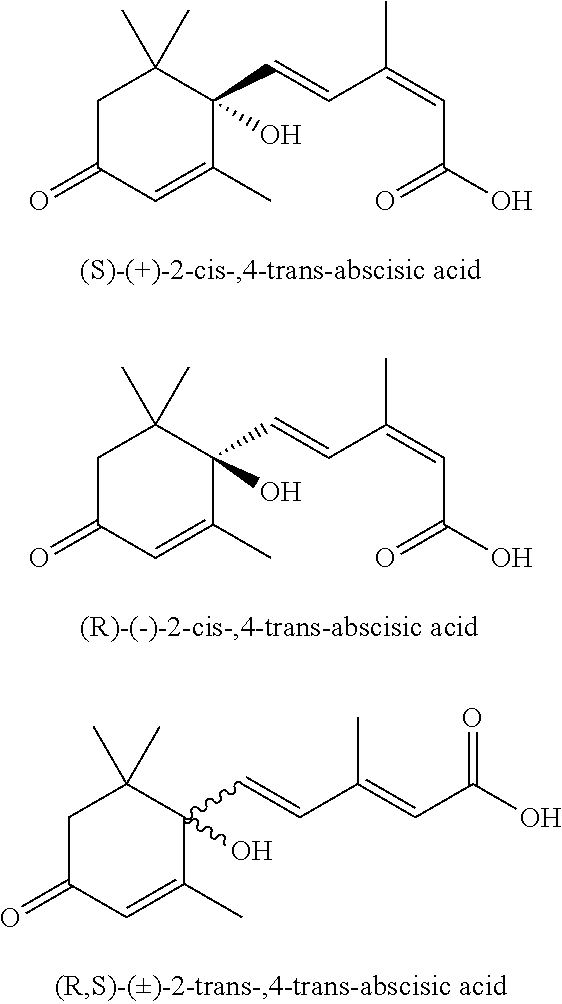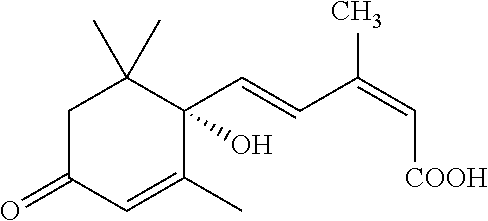Stable and non-precipitating aqueous compositions containing the potassium salt of (S)-(+)-abscisic acid, and methods of their preparation and use
a technology of abscisic acid and composition, which is applied in the field of color stable and non-precipitation aqueous compositions containing salts of (s)(+)abscisic acid, can solve the problems of inability to maintain color stability, reduce the commercial appeal of products, and unusable residual materials in food crops and the environment, etc., and achieves convenient packaging, storage, handling and application of plants, and high resistance to discoloration. , the effect o
- Summary
- Abstract
- Description
- Claims
- Application Information
AI Technical Summary
Benefits of technology
Problems solved by technology
Method used
Image
Examples
example 1
Preparation of an Aqueous Formulation Composition of the Potassium Salt of (S)-(+)-Abscisic Acid
[0043]An aqueous formulation composition was prepared comprising (S)-(+)-abscisic acid (97.7%) at a concentration of about 10.2% (10%) by weight of the total volume. The solution also contained 0.25% by weight of potassium sorbate, 0.50% by weight of sodium citrate, 0.50% by weight of sodium acetate, 0.25% by weight of Atlox™ 4913, 4.50% by weight of potassium hydroxide, and 83.8% by weight of water. The solution had a final pH of about 6.0 to 6.6.
example 2
Preparation of a Tank Mix of an Aqueous Formulation Composition of the Potassium Salt of (S)-(+)-Abscisic Acid with Ethephon
[0044]A tank mix solution was produced by mixing 200 mL of standard water with about 10 grams of the Formulation of Example 1 to prepare a solution with an (S)-(+)-abscisic acid concentration of about 5000 ppm. Then about 9.22 grams of Ethrel® (21.7% ethephon), available from Bayer Crop Science, was added to the (S)-(+)-abscisic acid to give a tank mix solution with an ethephon concentration of about 10,000 ppm. The standard water used was World Health Organization (“WHO”) standard water, prepared according to method WHO / M29.
[0045]The tank mix can be further diluted prior to application.
example 3
Improved Solubility of (S)-(+)-Abscisic Acid—Ethephon Tank Mix Solution
[0046]The composition of the tank mix solution of Example 2 is resistant to precipitation compared to tank mix solutions of the prior art. Applicants found that when (S)-(+)-abscisic acid solutions of the prior art were mixed with ethephon prior to application to plants, (S)-(+)-abscisic acid would precipitate from the solution. As discussed above, precipitation is of major concern because the precipitated product may block the application system and render the solution unusable. Additionally, efficacy of the solution will be reduced due to lower concentrations of the (S)-(+)-abscisic acid and ethephon active ingredients. Applicants prepared the Formulation of Example 1 without surfactant and then diluted the formulation to form a 5000 ppm (S)-(+)-abscisic acid solution. Three samples of this solution were mixed with three different surfactants. Then ethephon was added to each solution to give a 10,000 ppm concen...
PUM
| Property | Measurement | Unit |
|---|---|---|
| weight % | aaaaa | aaaaa |
| weight % | aaaaa | aaaaa |
| weight % | aaaaa | aaaaa |
Abstract
Description
Claims
Application Information
 Login to View More
Login to View More - R&D
- Intellectual Property
- Life Sciences
- Materials
- Tech Scout
- Unparalleled Data Quality
- Higher Quality Content
- 60% Fewer Hallucinations
Browse by: Latest US Patents, China's latest patents, Technical Efficacy Thesaurus, Application Domain, Technology Topic, Popular Technical Reports.
© 2025 PatSnap. All rights reserved.Legal|Privacy policy|Modern Slavery Act Transparency Statement|Sitemap|About US| Contact US: help@patsnap.com


